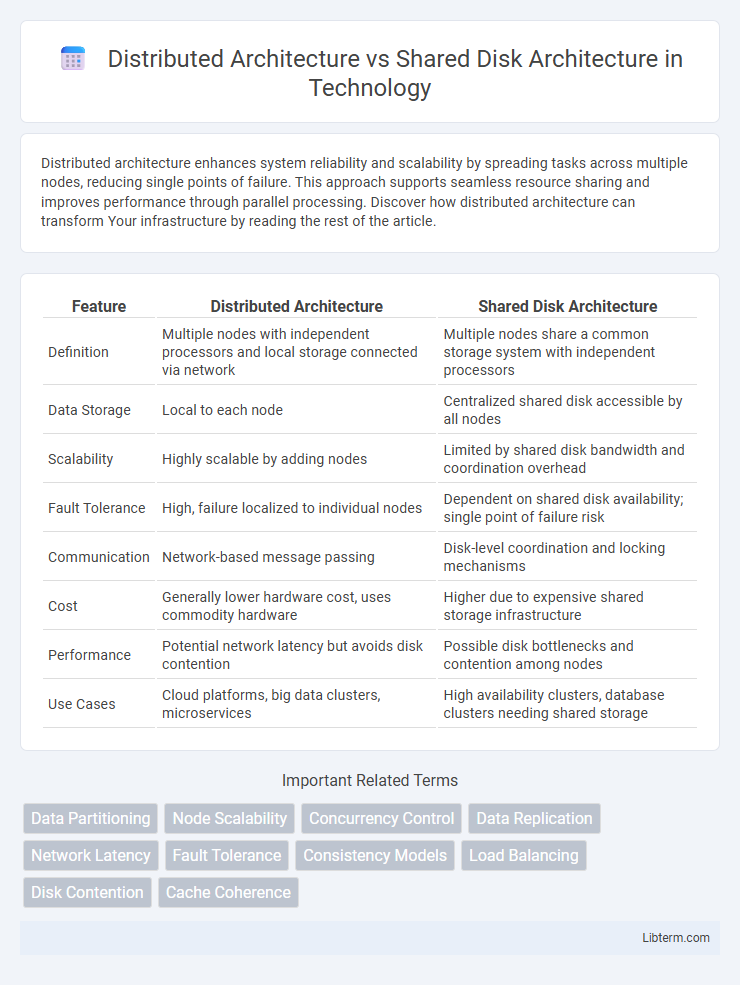Distributed architecture enhances system reliability and scalability by spreading tasks across multiple nodes, reducing single points of failure. This approach supports seamless resource sharing and improves performance through parallel processing. Discover how distributed architecture can transform Your infrastructure by reading the rest of the article.
Table of Comparison
| Feature | Distributed Architecture | Shared Disk Architecture |
|---|---|---|
| Definition | Multiple nodes with independent processors and local storage connected via network | Multiple nodes share a common storage system with independent processors |
| Data Storage | Local to each node | Centralized shared disk accessible by all nodes |
| Scalability | Highly scalable by adding nodes | Limited by shared disk bandwidth and coordination overhead |
| Fault Tolerance | High, failure localized to individual nodes | Dependent on shared disk availability; single point of failure risk |
| Communication | Network-based message passing | Disk-level coordination and locking mechanisms |
| Cost | Generally lower hardware cost, uses commodity hardware | Higher due to expensive shared storage infrastructure |
| Performance | Potential network latency but avoids disk contention | Possible disk bottlenecks and contention among nodes |
| Use Cases | Cloud platforms, big data clusters, microservices | High availability clusters, database clusters needing shared storage |
Introduction to Architectural Paradigms
Distributed architecture divides processing across multiple nodes, enhancing scalability and fault tolerance by distributing data and computation. Shared disk architecture centralizes storage accessible by all nodes, simplifying data management but potentially creating bottlenecks. Each paradigm addresses different needs in system design, balancing performance, consistency, and resource utilization.
What is Distributed Architecture?
Distributed architecture refers to a system design where computing resources and data storage are spread across multiple networked nodes, enabling parallel processing and fault tolerance. Each node in distributed architecture operates independently but cooperates through communication protocols to perform a unified function. This approach enhances scalability, reliability, and resource utilization compared to centralized systems like shared disk architecture, where multiple servers access a common storage device.
Understanding Shared Disk Architecture
Shared Disk Architecture centralizes data storage, allowing multiple nodes to access a single shared disk pool concurrently, which enhances data consistency and simplifies backup processes. This architecture supports high availability through coordinated access mechanisms, but requires sophisticated locking and cache coherence protocols to prevent conflicts and ensure data integrity. It is commonly used in clustered database systems and enterprise storage solutions where performance and data sharing are critical.
Key Differences Between Distributed and Shared Disk Architectures
Distributed architecture separates data storage across multiple nodes, enhancing scalability and fault tolerance by allowing independent data processing and failure isolation. Shared disk architecture centralizes data on a common storage system accessible by multiple nodes, which simplifies data consistency but may create bottlenecks and scalability limits. Distributed systems excel in handling large-scale, geographically dispersed data, whereas shared disk systems prioritize synchronized access with lower latency in tightly coupled environments.
Performance Comparison
Distributed architecture enhances performance by enabling parallel processing and reducing data access latency through locality, which is crucial for large-scale systems handling high transaction volumes. Shared disk architecture centralizes data storage, often resulting in bottlenecks due to concurrent access contention and increased communication overhead between nodes. Consequently, distributed systems outperform shared disk setups in scalability and response time, especially in environments demanding high throughput and fault tolerance.
Scalability and Flexibility
Distributed architecture offers superior scalability by allowing system components to be added or removed independently, supporting dynamic workloads and geographical distribution. Shared disk architecture centralizes storage, which can limit scalability due to potential bottlenecks and increased contention but provides flexibility in data access among nodes. The distributed model enhances flexibility through modular deployment and fault tolerance, while shared disk systems simplify data management at the cost of reduced scalability.
Fault Tolerance and High Availability
Distributed architecture enhances fault tolerance through data replication across multiple nodes, ensuring system availability even if some nodes fail, while shared disk architecture centralizes data on a single storage system, making its fault tolerance heavily dependent on storage redundancy and failover mechanisms. High availability in distributed systems is achieved by continuous synchronization and load balancing across nodes, minimizing downtime during failures. In contrast, shared disk systems rely on coordinated access control and storage-level clustering to maintain availability, which can introduce bottlenecks but simplifies data consistency management.
Use Cases: When to Choose Each Architecture
Distributed architecture excels in large-scale systems requiring high availability, fault tolerance, and geographic dispersion, making it ideal for cloud services, content delivery networks, and global e-commerce platforms. Shared disk architecture suits environments demanding strong data consistency and centralized control, such as database clusters, enterprise storage solutions, and high-performance computing applications. Choosing between these architectures depends on workload distribution, latency sensitivity, and the need for scalability versus data coherence.
Challenges and Limitations
Distributed architecture faces challenges such as network latency, data consistency, and fault tolerance, which complicate synchronization and increase system complexity. Shared disk architecture struggles with disk contention, scalability bottlenecks, and single points of failure, limiting performance and reliability. Both architectures require advanced coordination mechanisms to address these limitations and ensure efficient resource utilization.
Future Trends in Data System Architectures
Distributed architecture leverages multiple interconnected nodes to process and store data, offering enhanced scalability and fault tolerance compared to traditional shared disk architecture, which relies on centralized storage accessed by various nodes. Future trends emphasize the integration of edge computing with distributed models to reduce latency and improve real-time data processing, driven by advancements in AI and IoT applications. Emerging hybrid architectures aim to combine the high availability of shared disk systems with the flexible resource allocation characteristic of distributed frameworks, optimizing performance for big data and cloud-native environments.
Distributed Architecture Infographic

 libterm.com
libterm.com